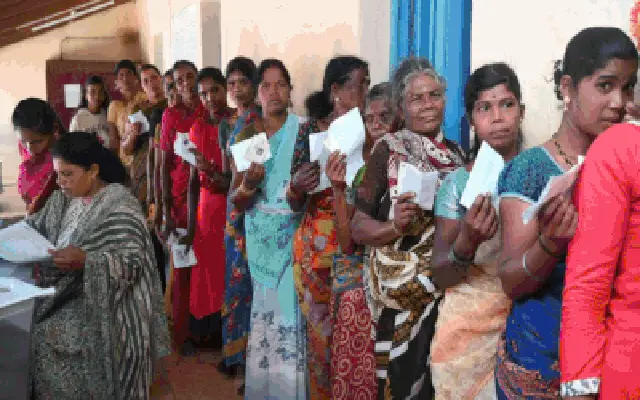Mumbai is implementing a long-delayed hawker policy that could significantly improve the lives and finances of street vendors.
For decades, the citizens of Mumbai have complained that street vendors are a menace to the city, blocking roads and pavements. Yet at the same time hawkers have flourished, largely because of a well-oiled system of haftas (weekly bribes) paid to the police, municipal officials and illegal rent collectors.
After almost three years of planning, last month the Brihanmumbai Municipal Corporation took its first steps to regularise street vending through licensing and creating designated hawking zones. In July, after surveying street vending practices for several months, the municipality began to distribute application forms for hawker licenses. By the end of the month they had distributed 1.3 lakh forms.
The Mumbai municipality stopped issuing formal licenses to street vendors 40 years ago, leaving a pool roughly 18,000 authorised hawkers. But Mumbai also has an estimated two lakh or three lakh unofficial hawkers.
The municipality’s initiatives were prompted by two important pieces of legislation. The Street Vendors Act, which came into force in May, recognised the rights of hawkers and the need to regulate the informal industry. The National Hawker Policy of 2009 mandated that a city should have at least as many licensed hawkers as 2.5% of its total population. For Mumbai, this works out to three lakh vendors.
So far, the lack of a formal policy on hawkers, both in Mumbai as well as other cities in India, has resulted in a proliferation of street vendors in congested areas, widespread failure to maintain hygiene standards, and blatant corruption.
Singapore’s Example
In the 1950s and 1960s, Singapore was in a very similar predicament. High unemployment led to an explosion in number of street vendors, and their low standards of hygiene were linked to the outbreak of several diseases. Officials perceived the hawkers to be a public nuisance, yet businesses on the street continued to thrive through bribery.
Singapore’s government opted for a range of interventions to create an environment in which street vendors were valued as an integral part of city life and assimilated into the city state’s renowned hawker centres – open-air complexes in which vendors sell cheap food and goods.
Mumbai could learn a few lessons from the Singapore model.
A shift in attitude
In the 1950s, Singaporean officials wanted to clear hawkers from the city’s streets but the public largely sympathised with the vendors, who were struggling to make a living. Singaporean researcher Azhar Ghani, author of a paper titled “Success Matters: How Singapore Hawker Centres Came to Be”, says this pushed authorities to alter their attitude towards street vendors and set up market stalls and shelters for hawker relocation.
“Hawking activities actually addressed a public need for cheap and convenient goods and services,” Ghani wrote in his paper. He adds that hawking at a stall was a family affair, which made the authorities more sensitive: any policy targeting street vendors would affect entire families.
As Singapore grew, it built more and more hawker centres to relocate as many street vendors as it could. Hawkers were moved from main streets to side streets, in order to address problems of traffic congestion.
Licensed hawkers in Singapore are required to pay rent for their stalls in these hawker centres, but for the most part, vendors are at an advantage. Hawking centres and street food available there are promoted as vital aspects of Singapore’s cultural life, and they draw thousands of tourists every year.
Singaporean sociologist Chua Beng Huat believes there is another reason for the authorities’ accommodation of food vendors throughout the city. “Inexpensive food keeps wages down, so it is a form of subsidising capital,” said Huat, a professor at the National University of Singapore.
Keeping hawkers close to their original sites
From 1971 to 1986, writes Ghani, the government started constructing markets everywhere possible, granting land to redevelopers only on the condition that they create hawker centres on that land. In doing so, the government also considered the need to relocate vendors to a site as close to their original point of business. This addressed the hawkers’ legitimate worries that they would lose their clientele.
In contrast, in Mumbai, the municipality spent Rs 29 crore in 2002 to build a five-storey Hawkers Plaza that was meant to house all the vendors from the central Dadar-Matunga area. But few hawkers were willing to move into the newly created market, because they realised that their clients – mostly commuters coming out of the busy Dadar railway station – would not bother climbing three or four floors in a relatively distant market just to buy basic groceries. Most of the stalls in the Hawkers Plaza has been empty for the past 12 years, though garment sellers occupy the ground and first floors.
Focus on hygiene
Hawkers were relocated in Singapore because of the threat of disease, and the garbage and pollution that came along with such unregulated trade. City authorities have ensured that all hawker centres are equipped with bathrooms, access to clean drinking water and facilities to maintain basic cleanliness.
Licensed hawkers in the city are required by law to follow rules on hygiene, which includes practices like not selling food that has been contaminated, or throwing dirty water or trash into open drains. Such steps ensure more tourists and locals come to such vendor markets.
Hawker entrepreneurship
Though Singapore no longer issues new licenses frequently, it is keen to preserve its heritage of street hawkers. In October 2013, the government introduced the Hawker Master Trainer Pilot Programme to encourage hawker entrepreneurship through tie-ups with the private sector. The programme involves on-the-job training with veteran hawkers in order to inspire aspiring vendors and “hone their culinary skills”.
Street food festivals
In May 2013, Singapore hosted the first ever World Street Food Congress, a 10-day festival celebrating street food. In December 2013, Delhi also had its first street food festival, organised by the National Association of Street Vendors of India.
“Such festivals not only serve to popularise street food but also make vendors realise the importance of maintaining hygiene,” said Sharit Bhowmik, a national fellow at the India Council of Social Science Research.
Bhowmik is also part of the two-member committee appointed by the Mumbai municipal corporation to offer suggestions for the creation of hawking zones. A well-defined and implemented policy could just revolutionise hawking in India, for vendors and customers.
















